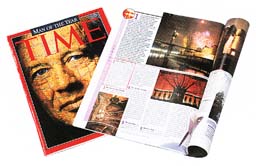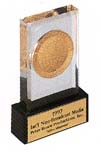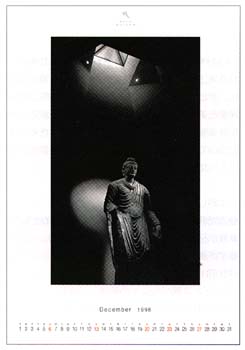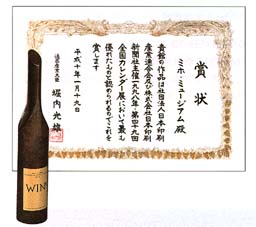The
MIHO MUSEUM Chosen as One of the
Best Designs of 1997 by Time Magazine
At
the end of each year, the American publication Time Magazine announces its
choices of the ten best items from around the world in a variety of categories
for that year. These categories include the best movies, music, books, scientific
and technological advances, people, scandals, and businesses. In the design
category, the MIHO MUSEUM was ranked number two of the best of 1997. Number
one was the Guggenheim Museum in Bilbao, Spain. The third was the New Amsterdam
Theater followed by the Getty Center in Los Angeles. Of the ten designs chosen,
six were architectural structures and, of these, three were art museums. The
Guggenheim Museum in Bilbao, designed by Frank Gehry, is part of the same
institution as the Guggenheim Museum in New York City. Some have remarked
that it looks as if a space ship had landed on the bank of the Nervion River.
The Getty Center consists of six buildings that house a vast art collection,
a museum, a library, and a research center. The structure, designed by Richard
Meier, took fourteen years to complete.

Between
these two large and important museums, the MIHO MUSEUM streaked unexpectedly
onto the list like a comet. The MIHO MUSEUM's collection first started gaining
public acclaim following exhibitions at New York City's Metropolitan Museum
of Art and the Los Angeles County Museum of Art that were held over the last
two years. But at the time, no one had a clue that a full-fledged museum would
appear in Shigaraki.
The museum was designed by the master architect I.M.
Pei, known for his many museum designs including the National Gallery in Washington
D.C. and Phase I and II of the Grand Louvre, with its celebrated glass pyramid,
in Paris. One day an image came to Mr. Pei of a gaping tunnel suddenly opening
deep in a range of mountains. After passing through the luminous, silver tunnel,
a suspension bridge appeared like a rainbow leading into the green mountain
slopes. From between the mountains' ridges, all that could be seen were a
glistening roof line and a small round entrance. But after climbing some stairs
to the entrance and passing through it, suddenly the interior opened to an
expanse of soft limestone bathed in glistening light and a vista of green
mountains spread out before his eyes.
The design of the MIHO MUSEUM recalls the paradise
that a lost fisherman discovered through an opening at the far end of a cave
in the Chinese classic story, "Peach Blossom Spring" by Tao Yuan Ming, or
it might resemble the ethereal images that are depicted in an idealized landscape
painting of fields and mountains. I. M. Pei, though based in the United States,
has not lost touch with the rich traditions and refinements of his native
China. The museum's founders had a passion for art that started with a love
of Japanese tea ceremony objects, a passion that grew to encompass art from
around the world. Visiting the museum, one senses the harmony of spirit that
exists in the architecture, the art, and the landscape and one also recognizes
the harmony of vision shared by of the founders and architect that was inspired
by "Peach Blossom Spring".
Today, the field of architecture is overflowing with
innovations and creativity. That three magnificent museums would open in the
same year and meet with general acclaim for their design is cause for joy.
The unique and invaluable service that each of these museums will perform
for the world of art is keenly anticipated.
MIHO
MUSEUM Video Wins Gold Medal
at the New York Festivals

The
New York Festivals, an event that recognizes and commends works in a variety
of creative media that have deeply impressed viewers, awarded a gold medal
to a video documentary about the MIHO MUSEUM by Peter Rosen in the "Public
Relations-other" category. This category is one of the most important in the
event. Approximately 200 works from around the world were considered for this
prize, of which only twelve received gold medals.
The MIHO MUSEUM Calendar
Awarded
the Ministry for International Trade and
Industry's Prize in the 49th All-National
Calendar Exhibition
The All-National Calendar Exhibition has three award divisions: First Division, Best Calendars for Regular Corporation or Printing Company; Second Division, Best Calendars for Sales Promotion, Premium, or Publishing Company; Third Division, Best Calendars for Single Sheet, Small Size, Desktop, Special or Private Calendars. The MIHO MUSEUM calendar was awarded the Grand Prize in the Second Division. Since this marked the first appearance of a MIHO MUSEUM calendar in the exhibition, it was an especially rare honor to be recognized so suddenly as the Ministry of International Trade and Industry's prize. According to Nakamura Katsuhiko of N.C.P Co.,Ltd., who served as one of the judges for the competition, every member of the judging committee voted for the calendar, making it unnecessary to cast a decisive vote in the final selection stage of the competition. The museum structure, the subject of the photographs in the calendar, was very popular among the judges, all of whom expressed a desire to visit the museum in the Spring. In addition, the calendar was exhibited at the International Calendar Exhibition held in Stuttgart, Germany, where it was awarded a silver medal. It also won two prizes in the Kodak Photo Calendar Competition.

